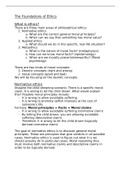Class notes
Class notes on Ethics (W_BA_PNEU)
- Course
- Institution
Detailed notes on the foundations of ethics. Includes normative ethics, trolleyology, kantian deontology and utilitarianism. Looks at hypothetical ethical scenarios to further explore the foundations of ethics.
[Show more]



